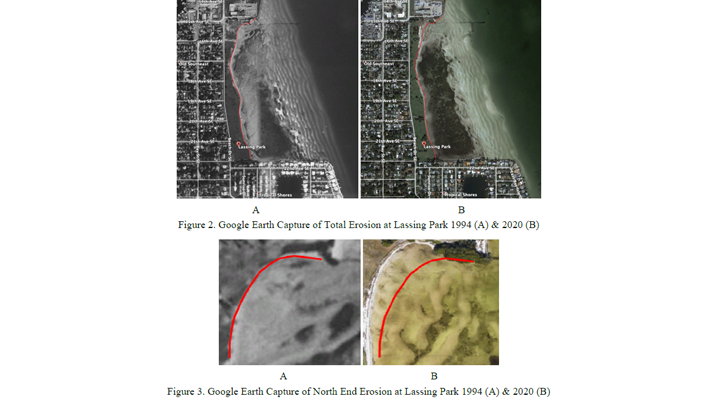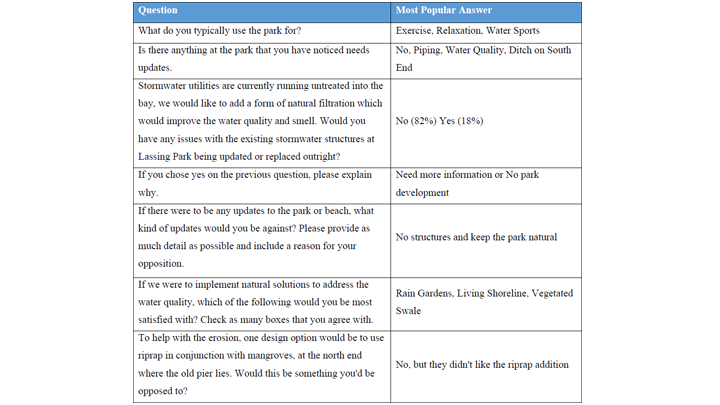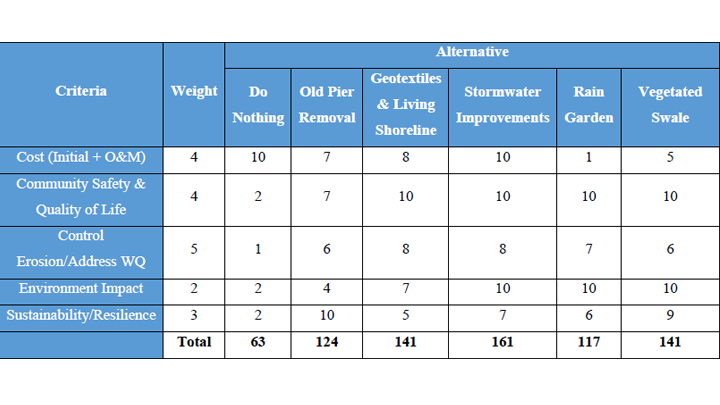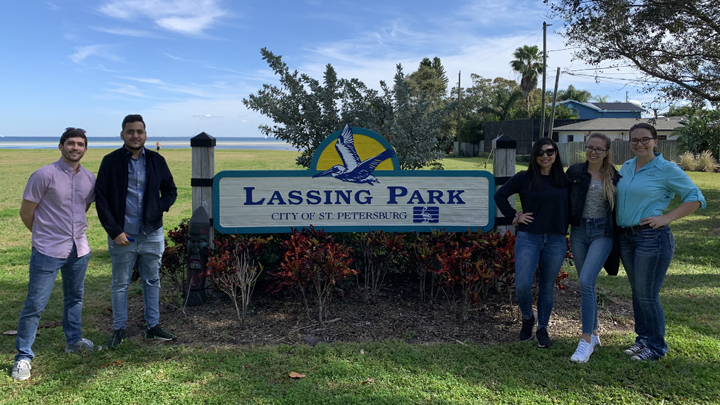Named Aqua Engineering, a team of five USF civil and environmental engineering students won first place in the environmental design division of the 2021 Florida Water Environment Association Student Design Competition.
This was the first time any of the five students — Jordin Kahler, Alexandro Orellana, Mariko Peltz, Andres Lora Santos and Anna Zimmerman — had competed in one of the association’s student design competitions.
USF Department of Civil and Environmental Engineering professor Sarina Ergas said that the elements of the project made it a valuable experience for each of the team members.
“This was a wonderful project in that it addressed issues of beach erosion and stormwater runoff, while engaging students with utility partners in St. Pete,” Ergas said. “The students gained a lot of insights by engaging with local community members and listening to their needs.”
The competition was created to provide water engineering and water science students with real-world design experience, as described on the association’s website. It tasks teams to work on a wastewater or environmental design project report that could be realistically implemented for actual clients facing a water-related problem or challenge.
Zimmerman said that the format of the project was similar to project design reports she’s worked on during an internship, down to how they’re broken up into phases, how the work is proposed and how regular contact is kept with project clients.
“Even though I have previous experience reading and helping with scopes of work, I’ve never started one from scratch, so it was a very helpful experience for me,” she said. “The technical writing, the calculations, the math, trying to figure out if it’ll work or not, the professionalism you build speaking to city representatives — it’s all experience for real-world projects.”
Aqua Engineering’s client was the City of St. Petersburg, assigned during the team’s capstone design course. City staff tasked the team with evaluating Lassing Park and designing stormwater proposals for improving water quality and erosion there. A 14.2-acre city park overlooking Tampa Bay, Lassing Park is used by many St. Petersburg residents as a place to walk their dogs, kiteboard, fish, swim, have a picnic or go for a walk.
While taking a site visit with a City of St. Petersburg stormwater engineer to evaluate the park, the team found fractured and buried storm drains with exposed rebar, as well as eroded drainage ditches holding stagnant water topped with an oily film.
After examining the park, the team also examined satellite images taken of the park from 1994 to 2020, as well as water quality sample test results from the park taken in 2018 and 2019. They found noticeable signs of the park’s erosion over the decades and relatively high levels of phosphorus and the bacteria Enterococci in the park’s brackish water.

As included in the USF team’s project report, Lassing Park’s shoreline has receded around 20,000 feet since 1994.
To address both the erosion and poor water quality ailing the park, the five USF students included five possible solutions — remove an abandoned pier at the north end of the park to allow natural sediment transport, called longshore drift, to help slow erosion there; install geotextile sandbags, a coir turf reinforcement mat, an oyster reef and plant red mangroves to help stabilize the shoreline; improve existing stormwater structures; plant a bioretention garden to naturally filter the largest source of stormwater that feeds into the park; and plant a vegetated swale at the south end of the park to reduce stagnant water.
Not only did Aqua Engineering’s solutions need to be effective and affordable, they also needed to meet the expectations of local residents in the two neighborhoods that surround Lassing Park. To gauge residents’ interest in possible transformations that they would or wouldn’t want to see made to their park, Orellana and Peltz went door to door in the neighborhoods handing out 300 surveys over two days.
“The biggest learning experience for me was figuring out how to balance the wants of the city and the project they wanted to do with the wants and needs of the surrounding community,” Orellana said. “The community was really involved and very particular about the things they did and did not want done to their park. My other projects have been framed as, ‘Here, this is what you’re doing.’ This became, ‘Figure out a way to do it without making the wrong people mad.’”

In the team’s survey handed out to 300 St. Petersburg residents, most expressed a desire to keep Lassing Park as close to its natural state as possible.
Residents’ sentiments added a layer of difficulty to narrowing down potential solutions, as many responses highlighted a clear hesitancy to agree to any kind of development of the park. This included removing the rubble from the abandoned pier, as many relied on the sediment built up around it to walk out to a sandbar at high tide.
A solution proposed previously to the project by Bay Area nonprofit Tampa Bay Watch included a living shoreline with oysters, which was scrapped, as it would have created a safety hazard for residents walking their dogs in the surf and potentially cutting their feet on loose oysters that wash up onto the beach. This was a clear sign that residents would not support the oyster reef component in the shoreline stabilization solution of Aqua Engineering’s project.
At points throughout the project, the team worked with USF St. Petersburg marine science professor Cheryl Hapke, who lives near Lassing Park and has studied the park’s shoreline. In their discussions with Hapke, they learned about the longshore drift taking place at the park and other important details needed to finalize their proposed solutions that dealt with its erosion.
“We didn’t have too much background on erosion, so her guidance was really the hammer to the nail on finishing that section of the project,” Kahler said. “She really pushed us to the finish line.”
In addition to coming up with feasible solutions for remedying water quality and erosion at Lassing Park, the team’s report needed to include other sections on calculations and costs and models to guide their implementation. The models alone included stormwater management models (SWMMs), overhead and sideview illustrations of how the living shoreline, vegetated swale and bioretention garden would look, CAD models of the structures that would improve the park’s storm drains, and 3D models and schematics of the park’s stormwater pipe network.
Luckily, each of the five team members had skillsets that supported one another’s. Some were better at technical writing, making presentations and public speaking, while others were more suited for technical modeling work or figuring out the math behind improving the park.
“It took all of us working hours and late into the night working on it.” Kahler said. “I remember being up till 2 a.m. some nights just trying to get it done. It took the whole semester to do.”
“A lot of the people on our team are perfectionists and hard workers in general,” Zimmerman said. “I think it’s shown through our report and the extra elements we weren’t required to have, like the AutoCAD drawings and use of ArcGIS. I think that helped us get first place because the judges saw how much effort we put in that we didn’t have to and because we had the interest to try new tools.”
Each member of the team also said the project provided them with different learning experiences. Zimmerman said she liked the experience of working on a real-world project report, while Orellana said his biggest learning experience was balancing the city’s expectations of the project with those of the surrounding communities.
Lora Santos said the project gave him a comprehensive look at modeling a stormwater network in AutoCAD subprogram Civil 3D.
“We had a limited number of pages and couldn’t include all of it, but in total I created 18 plans for eight stormwater pipes,” he said. “We had two for each pipe and two for the general network.”
Kahler said it gave her a chance to improve her technical writing and presentation skills, as well as being the most involved team project experience she’d had all year.
Peltz said that researching the necessary local, state and even federal permits needed to carry out the parts of the proposal was a new experience for her.
“It was everything from general building permits to moving mangroves and redistributing mangroves,” she said. “It was quite extensive.”
After analyzing the five original solutions in an evaluation matrix that took cost, community preference and effectiveness into account, Aqua Engineering’s final proposal to the City of St. Petersburg was broken into four phases —improve the park’s stormwater infrastructure, install the vegetated swale at the south end of the park, install the geotextiles and mangrove living shoreline and finally, if funding can be secured, construct the bioretention garden. Splitting the plan into phases allows the park to stay open throughout the construction and adds clear priorities.

The two possible courses of action in the team’s evaluation matrix with the lowest scores are doing nothing and removing the old pier, which were removed from the final version of the proposal.
As part of winning the student design competition, Aqua Engineering was awarded a $1,000 Norm Casey Scholarship and a $4,000 travel allowance to the 2021 Water Environment Federation's Technical Exhibition and Conference (WEFTEC) in Chicago. Here, the team will have the chance to compete in the national FWEA student design competition when the conference kicks off in October.
